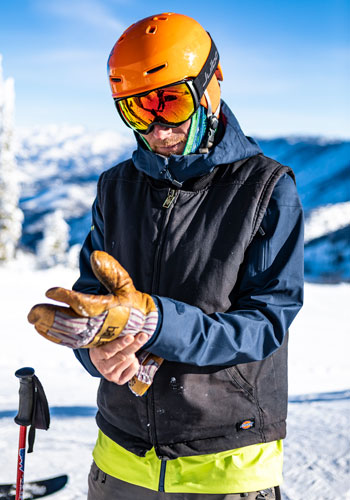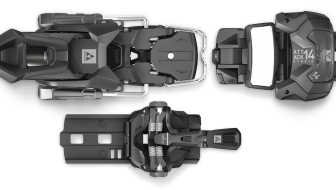[This article will also appear in the November 2019 issue of Backcountry Magazine and is part of our week of climate change coverage, through which we hope to build awareness, dialogue and action around the topic as our alpine communities become increasingly impacted.]

When I started skiing as a college kid in Colorado, hell-bent on becoming a skier but entirely clueless, I somehow knew who the dedicated skiers were at my go-to resort, Arapahoe Basin.
With an inimitably cool slide into the lift lines, they shared a soft-spoken camaraderie and an unassuming aura. They wore faded, nondescript jackets and pants, a visual byproduct of years spent skiing. Outerwear like theirs prioritized fast laps over fashion; these were not people who wasted money or time on frivolities like replacing gear to match a marketing campaign.
The ethos of those skiers stuck with me as I moved to a new town, and as I ponied up for new ski pants, an instantly beloved gray pair that lasted four years. I wore them through winter and spring tours and while scrounging around the Andes in August and September. They became faded, ripped, sewed and entirely worn out. They defined an entire era in my skiing, one where I logged serious hours and committed fully to the sport.
Now, I hardly ever see anyone wearing worn-in ski gear. Just after my gray-pants era, I realized everyone I skied with and looked up to wore brand-new garb, even stuff from the next season. I, too, began to lust over these bright, fresh colors, and when a well-respected gear company began to support my skiing, I couldn’t wait to show off how I’d been validated each December.
But we had all begun to miss the point. Authentication as a skier doesn’t come from your clothes—now referred to as a kit—and you can’t buy the genuineness of my original ski heroes or their easy confidence. The kit isn’t the point; it’s simply a vehicle.
More importantly, it’s easy to forget, even among our single-use-plastic-shunning, bike-commuting, recycling, backcountry-skiing selves, that everything about ski gear is resource intensive. These high-performance textiles are far from low impact; they are piles of environmentally costly, petroleum-based (that’s plastic, friends) textiles with chemical coatings you wouldn’t spray on your salad. So why are we so eager to replace them each season?
Americans reportedly trash 81 pounds per capita of clothing per year, but if we spend more than $1,000 on durable, quality outerwear, shouldn’t we wear it ’til it’s fully worn? It’s not hard to keep quality gear going, between aftermarket treatments and cleaners and brands that will repair their gear for you. Flylow and Mammut are two such companies, as is Patagonia, which offers its Worn Wear program to patch and mend their apparel and encourages people to repair their gear, rather than replacing it too quickly. Arc’teryx’s new Rock Solid program allows people to send in gear that’s not being used for credit, and others can buy this used gear.
Still, “used” hasn’t returned to its once-cool status. Recently, I took some layers I was no longer wearing to a gear consignment store. I held up last season’s barely worn midlayer to the store’s buyer and offered to sell it for what I thought was a realistic price given its quality and condition.
“Hmm,” the buyer said, poking it. “It looks used.” He indicated a pea-sized discoloration on the side, and we went back and forth on price until I suggested, “What if we sell it for $30?” He pushed the item aside in reply, and I sighed.
What’s happened to us? How have we lost the ideals that drove ski bumming’s origin, where people just wanted to have fun, enjoy the brilliance of life and shun the beaten path?
A few years ago I realized these clothes, while they may be marketed as newer and better every season, are perpetually built to last. The longer you wear your gear, the lower your own impact becomes and the less you cave to the pressures of our consumer-based world. I wasn’t buying new gear every season, but through my sponsor’s generous yearly kits, I was still participating in the cycle.
So I stopped asking for new gear. I dug around for my 13-year-old black softshell and put on my favorite—and first—bibs, a dark grayish-blue pair, used for two seasons. Barring a crampon hole in one leg, neatly taped from the inside, the fabric has that supple look I once admired on skiers from afar. The DWR is long gone, but the Gore-Tex still wards off weather. Heightened memories of the powdery lines, fun times and accomplishments I had while wearing these pieces washed over me. I suddenly felt like myself again; just a skier in some ski clothes.
I called a friend for a tour, and we headed out to enjoy the treasures of the natural world—and to search for some kit-concealing powder on the way down.
—
Brigid Mander skied her first two days ever at Colorado’s Monarch Mountain in borrowed purple ski pants and a blue and hot pink striped hand-me-down CB Sports jacket. If only she’d had the foresight to keep that jacket….










Related posts: